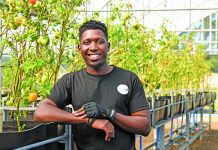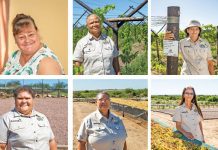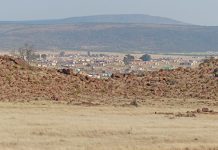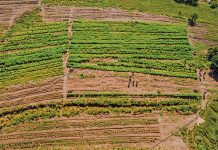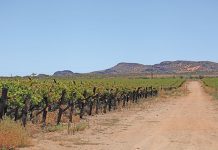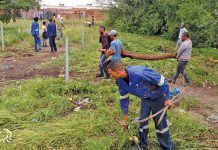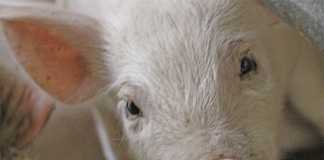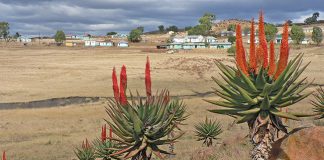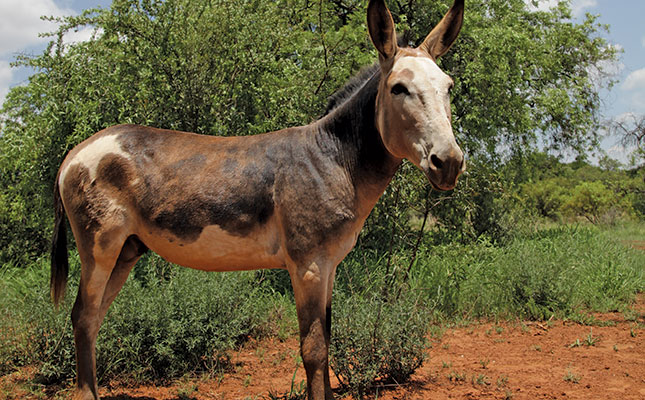
Photo: Gerhard Uys
“It’s their temperament and character that fascinate me the most. People don’t realise how intelligent they are,” says Gerrit van de Pypekamp, a breeder of spotted donkeys.
The Pretoria-based biochemical engineer owns a biotechnology company; his venture into donkey breeding was thus unexpected.
His father, Hans, began breeding Nguni cattle in the 1980s on his farm near Coligny. Some years ago, the stud lost calves to predators, and Van de Pypekamp started investigating keeping donkeys with the cows, as they reportedly make excellent herd protectors.
“I wanted to test this theory, but couldn’t find a donkey, as no one sold any,” he recalls.
“Then I saw a photo of a spotted donkey and realised I wanted something beautiful like that to walk with the cattle.
“I began searching for spotted donkeys but found only references to them overseas. I put the word out with horse traders, and found my first spotted donkey in 2012. From there, word spread that I wanted to buy spotted donkeys and I found more isolated groups of them across South Africa.”
He now has 60 of the animals, sourced mainly from communal areas.
Van de Pypekamp admits that at first he did not understand the colour genetics, and neither did he have a clear breeding plan.
“Because there are only small and isolated genetic pockets, there was no selection. My fear was that through inbreeding, and the general decline in the donkey population, these spotted donkeys would soon disappear. I don’t just collect donkeys; I select breeding material to preserve and improve traits while selecting for specific colour patterns,” he says.
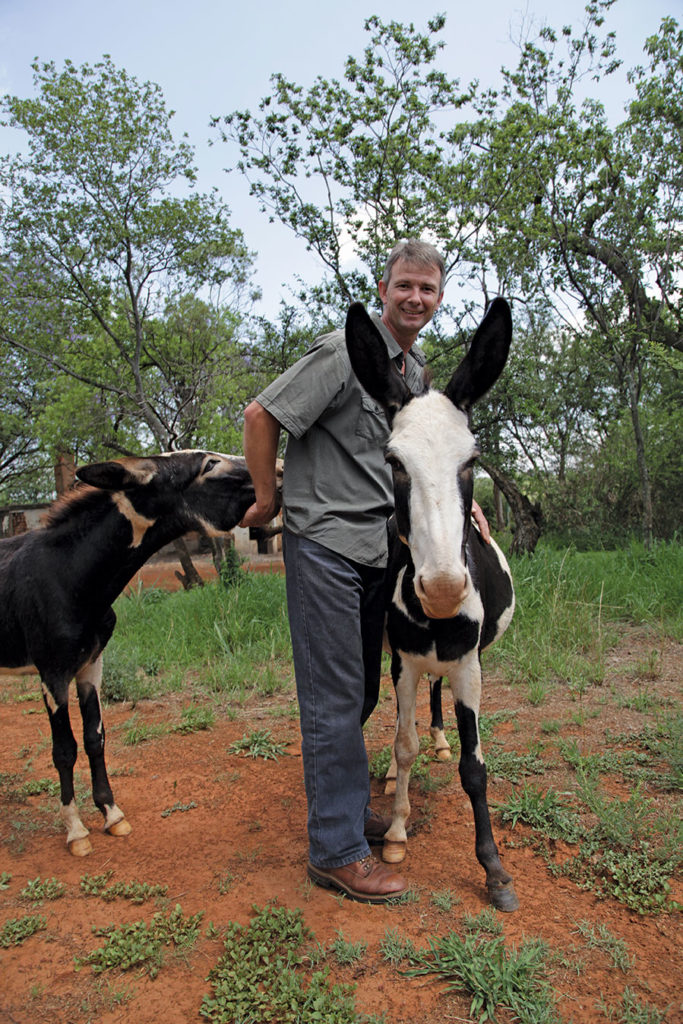
Van de Pypekamp does not have a farm himself. Instead, he runs his donkeys on a number of smallholdings between Montana, in Pretoria, and Cullinan, where they keep the grass short for the owners. He checks up on the animals several times a week, helps keep an eye on the properties (crime is an ongoing problem), and assists with upkeep and fencing.
Wide range of colours
‘Normal’ donkeys come in a variety of base colours. The most common is grey dun, with lighter colouration on the muzzle, eyes, ears and belly, and a dark stripe over the shoulder and back. Other colours are black, bay, brown-black, sorrel, red dun, white and chocolate.
Spotted donkeys, in contrast, exhibit a huge variation in their colours and patterning. The general form is white on a dark base colour.
The extent of spotting varies, with the first signs of the spotted gene manifesting as a white blaze with white socks. These donkeys are referred to as ‘minimally spotted’.
The dam and sire each have two copies of colour genes. During breeding, they each pass one of these genes to the foal. Research has established that the spotted colour gene is dominant, but always pairs with a recessive, solid-colour gene.
There is never a recessive spotted gene, and never a double-spotted gene. As the spotted gene is dominant, it will always show when paired with the recessive solid-colour gene.
However, as all spotted donkeys carry a recessive solid colour gene, the recessive genes may pair during mating. In this case, a solid-coloured foal will be produced, and it is thus possible for two spotted donkeys to produce a solid-coloured foal.
While Van de Pypekamp has identified and selected six genetic colour lines, he breeds three distinct colour variations.
Sweet Spot, one of his mares, is a perfect representation of how a black and white-spotted donkey should look. He also breeds a white and grey line. His stallion, De La Rey, is an example of the third colour variation.
“De la Rey carries the biscuit and tricolour genetics. These are completely different from the other spotted genetics. His offspring are tricoloured, with a biscuit colour around the eyes. When you blindly select only for the spotted colour pattern, you run the risk of losing important traits such as pigmentation and conformation.”
Stallions such as De la Rey are ideal for breeding, as their genetics endow their offspring with good pigmentation around the eyes and nose.
Van de Pypekamp also selects for conformation.
“I breed specific lines, but I keep them apart as the gene pools are so small and I don’t want to inbreed. I breed stallion lines primarily. I’m not at the stage where I have to worry about inbreeding, but I do introduce new blood by bringing in new mares,” he says.
Each mare produces one foal a year at most. Van de Pypekamp uses single-sire breeding, which is made easier by the fact that he runs his donkeys on multiple agricultural holdings and simply moves stallions from one place to another for breeding purposes.
“You have to decide what the ideal donkey is that you want to breed and then follow that plan. I aim for the desirable traits and try to eliminate the rest. It may not be an exact science and it takes several generations to achieve those targets. One must also use traits from standard solid patterns,” he says.
Character and maintenance
Van de Pypekamp says the donkeys quickly dispelled his belief that they were dumb and had no character.
“They are stubborn. But they’re very intelligent and highly social,” he says.
Not as large or intimidating as horses, and excellent with children, they make ideal pets for people on agricultural holdings.
Van de Pypekamp has not measured how much his donkeys eat, but says they consume grass and shrubs that are unpalatable for cattle. Without additional feed, and depending on the quality of grazing, he estimates they require between 2ha and 4ha of grass to survive a year. He does, however, grow some grass that he bales for winter.
“Donkeys are low maintenance, are kept on the veld, don’t need to be stabled, and don’t have to be brushed or have their teeth filed. They offer huge advantages for those who want to have them as pets and don’t have time for the effort that goes into keeping a horse.
“They’re very hardy, although I do vaccinate them against African horse sickness and have to treat them occasionally for ticks.”
While he has sold only a few donkeys, he says they are for sale to those who are interested. He sees no need to sell any, however, as his aim is not to breed a large number, but help preserve the gene pool.
“I sell those that aren’t spotted for a lot less, but I make sure they’re priced so that the buyer makes a commitment to care for them, and even more importantly, that someone doesn’t buy them for slaughter.”
The future
Van de Pypekamp plans to start keeping records of breeding and parent lines. He says there is a place for donkeys as pets, companions for other farm animals, and herd protectors.
Whenever he hears of someone who has a spotted donkey, he tries to find out if it is from a gene pool independent of his own donkeys. He believes he knows all the spotted gene pools in South Africa, and that with the genetic diversity he has now, he will not reach a stage where inbreeding becomes a problem.
Van de Pypekamp has clear favourites among his donkeys, and says that some animals stand out because he reached a breeding goal or because of their specific character and bond with him. For example, a foal named Hopper was born prematurely during a heavy storm. He thought it would not survive the night.
“To my surprise, he survived. The next day, I made him a jacket using a raincoat.” Today Hopper seems to be especially fond of Van de Pypekamp.
“The South African donkey population is declining rapidly. Fewer donkeys are being used as working animals and they are simply not kept due to grazing pressure in communal areas. The profile of donkeys must be raised,” he says.
Email Gerrit van de Pypekamp at [email protected].

